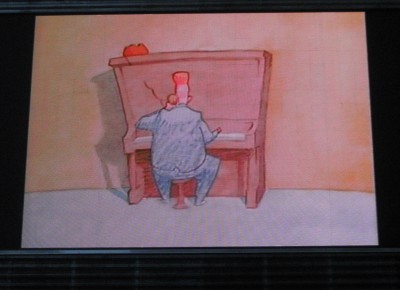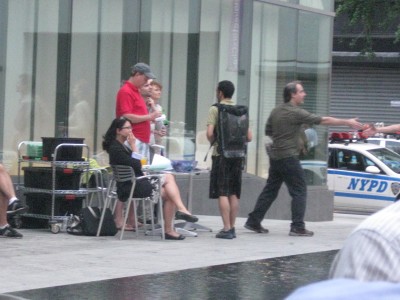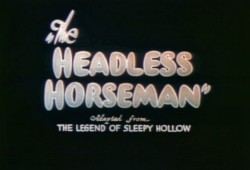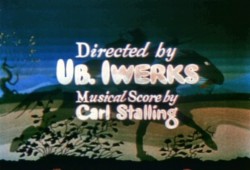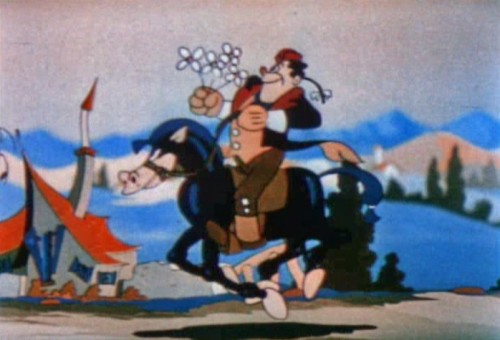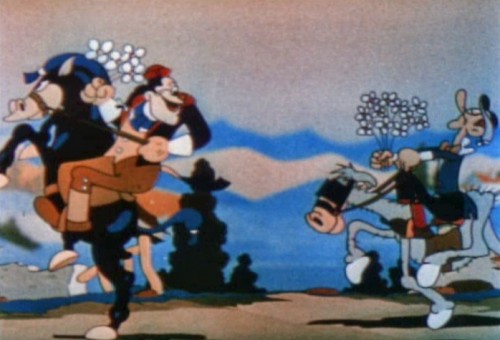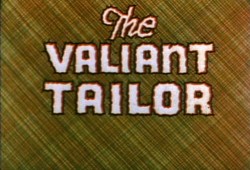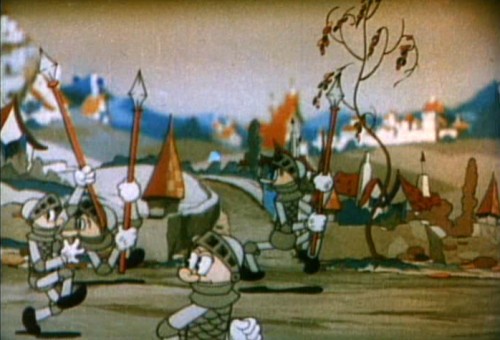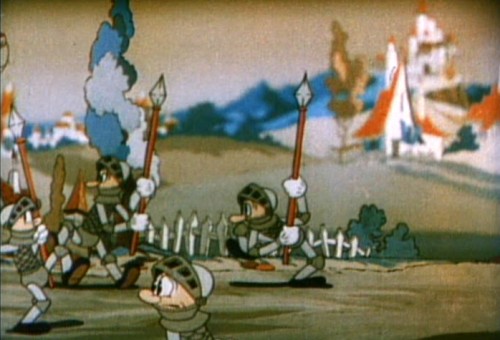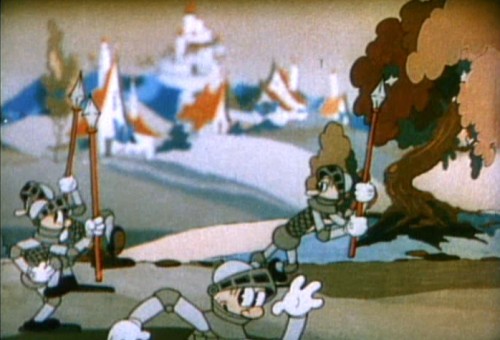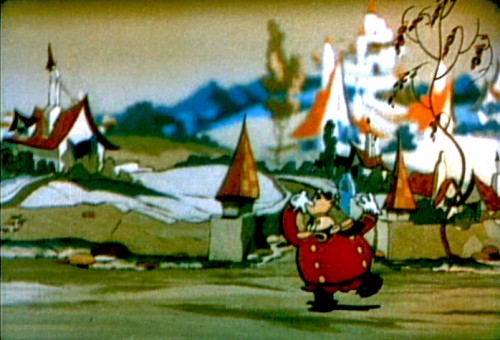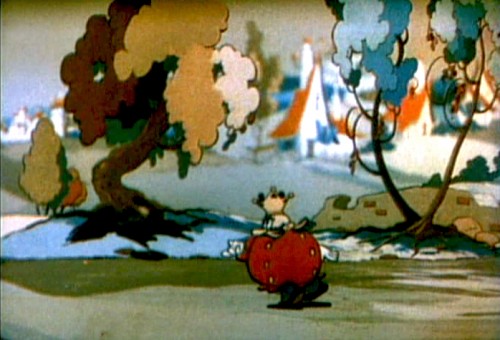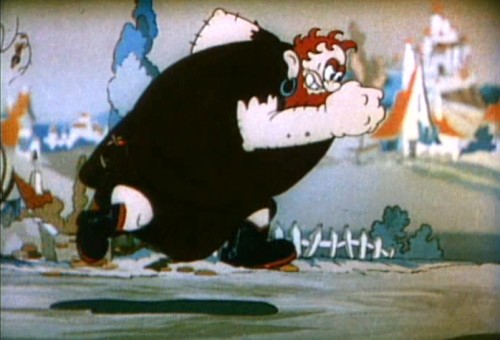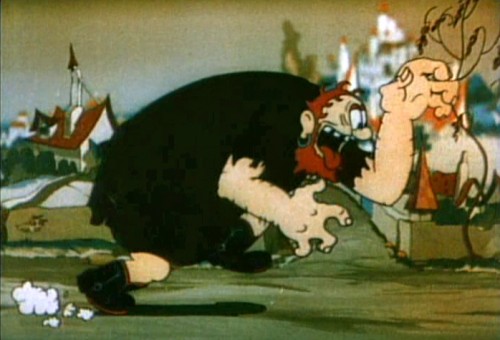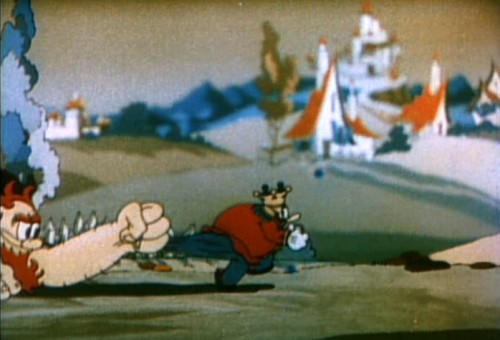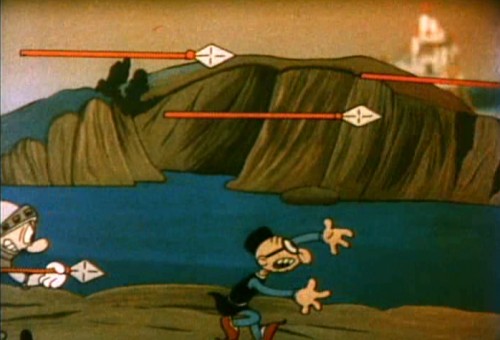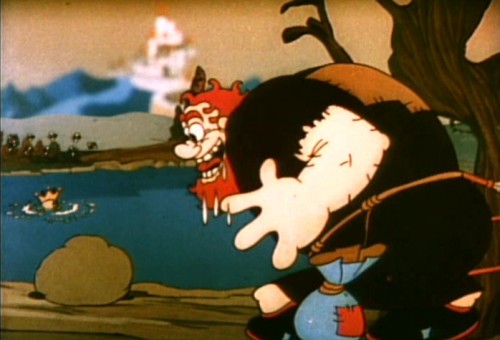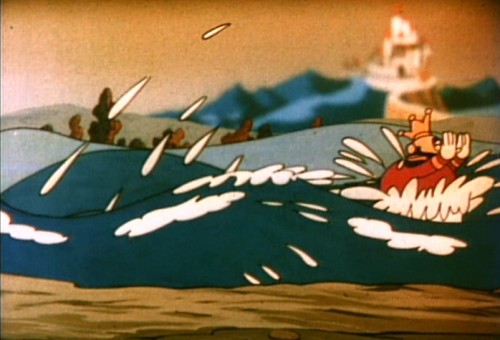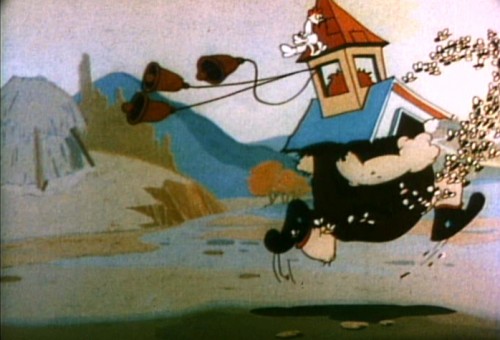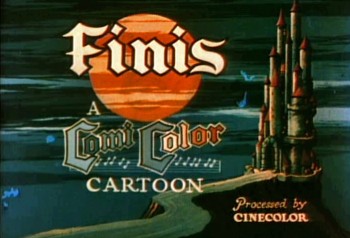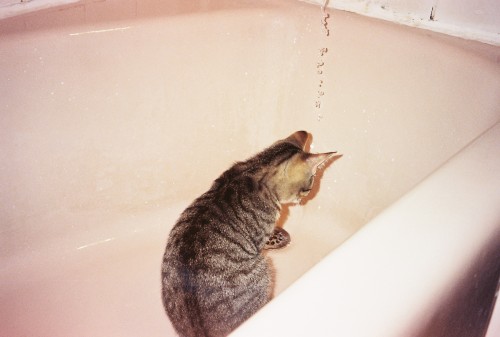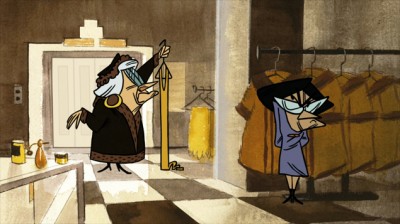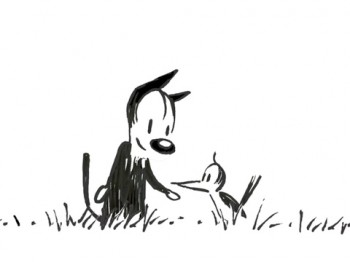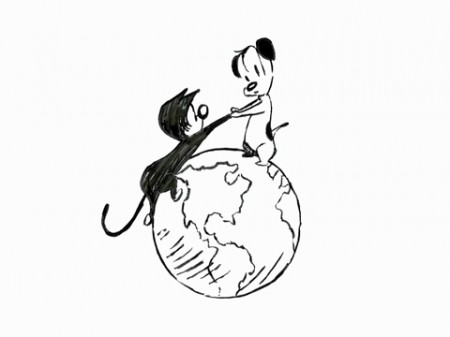Category ArchiveCommentary
Commentary 03 Sep 2011 06:55 am
Schmoozing
 - Mike Barrier posted a letter on his site. Kevin Hogan questions Mike’s ability to enjoy an animated film now that his taste has been formed by a lot of information learned over a lifetime of study. Mr. Hogan gives as an example the Chip n’ Dale cartoon Two Chips and a Miss. He loved this short as a child and found himself not enjoying it quite as much seeing it as an adult. He suggests that Mike’s knowledge might get in the way of the “innocence” he had as a child in enjoying some of these films. It’s an honest question, and it opened into a full discussion with Thad Komorowski and Milt Gray among others discussing the theory. Mike talks about enjoying the Three Stooges in his younger days but not quite enjoying them as much in recent days. His knowledge of film and this thoughts on the filmmaking process inform his judgment (thank god).
- Mike Barrier posted a letter on his site. Kevin Hogan questions Mike’s ability to enjoy an animated film now that his taste has been formed by a lot of information learned over a lifetime of study. Mr. Hogan gives as an example the Chip n’ Dale cartoon Two Chips and a Miss. He loved this short as a child and found himself not enjoying it quite as much seeing it as an adult. He suggests that Mike’s knowledge might get in the way of the “innocence” he had as a child in enjoying some of these films. It’s an honest question, and it opened into a full discussion with Thad Komorowski and Milt Gray among others discussing the theory. Mike talks about enjoying the Three Stooges in his younger days but not quite enjoying them as much in recent days. His knowledge of film and this thoughts on the filmmaking process inform his judgment (thank god).
I probably would have gone to Alfred Hitchcock. Here’s someone who made films that can and should be appreciated on so many levels. They’re done for the public, and the manipulation Hitchcock maneuvers to create his films gets that audience by the throat, and Hitchcock enjoys doing so. Yet that same manipulation becomes obvious to the informed film student. However, for that same knowledgeable filmgoer, it doesn’t lessen the value of the film knowing how and what is coming. It makes it more fun because Hitchcock was a Master.
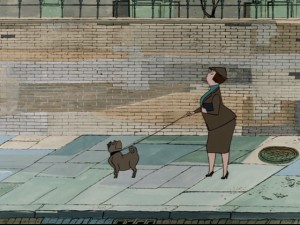 - As a 14 year old child, I was blown away by 101 Dalmatians. Those first ten minutes were heaven to me. I loved the design and the animation of Cruella de Ville, Pongo & Perdita, and even some of the pups. I was not as enthralled by the middle action-adventure section (immediately following the “Twilight Bark”). I had a lot of respect for what was being done, but I preferred the London portion of the film. I did know a lot about animation when I first saw it, but I know a lot more now. I also, now, know quite a bit about 101 Dalmatians, itself. The odd thing is that my opinion hasn’t changed a bit since that first screening. Today, I am in awe of the beautiful walk cycles Blaine Gibson animated at the beginning of the film as Pongo eyes potential mates. Throughout the film, I can see all the cuts, cel shadows, interesting effects and mistakes within them, and, yet, I still love the movie. Everything has changed within me, but nothing has changed within the movie that I first saw. It’s still excellent.
- As a 14 year old child, I was blown away by 101 Dalmatians. Those first ten minutes were heaven to me. I loved the design and the animation of Cruella de Ville, Pongo & Perdita, and even some of the pups. I was not as enthralled by the middle action-adventure section (immediately following the “Twilight Bark”). I had a lot of respect for what was being done, but I preferred the London portion of the film. I did know a lot about animation when I first saw it, but I know a lot more now. I also, now, know quite a bit about 101 Dalmatians, itself. The odd thing is that my opinion hasn’t changed a bit since that first screening. Today, I am in awe of the beautiful walk cycles Blaine Gibson animated at the beginning of the film as Pongo eyes potential mates. Throughout the film, I can see all the cuts, cel shadows, interesting effects and mistakes within them, and, yet, I still love the movie. Everything has changed within me, but nothing has changed within the movie that I first saw. It’s still excellent.
- Jeffrey Pepper’s excellent website 2719 Hyperion has featured the odd Disney short, Donald and the Wheel, in a fine analysis. The article was originally posted on the site in 2009, but this is the first time I’ve caught up with it.
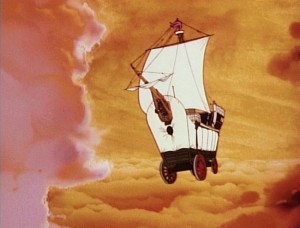 I initially saw this short when it was originally released in 1961. It played locally in New York on a bill with a non-Disney live-action feature (which I can’t remember.) I have to say that I wasn’t in tune with this short, but I enjoyed the surprise of seeing it in the theater back then.
I initially saw this short when it was originally released in 1961. It played locally in New York on a bill with a non-Disney live-action feature (which I can’t remember.) I have to say that I wasn’t in tune with this short, but I enjoyed the surprise of seeing it in the theater back then.
An even greater delight for me was seeing Symposium of Popular Song with the film, P.T. 109 in 1963. Also on that bill was the Disney animated short, The Saga of Windwagon Smith. I don’t remember that much about the feature (other than an image of Cliff Robertson as JFK), but I do remember the two shorts which I’ve seen many times. I absolutely love Windwagon Smith and have studied it backwards and forwards. I also bought a couple of drawings when I saw them available on ebay. Symposium of Popular Song took the TV creation, Ludwig Von Drake and introduced him to theaters in this Bill Justice/Xavier Attencio short that was primarily stop-motion cut out animation. What a double bill! And I’m talking about the shorts, not the feature.
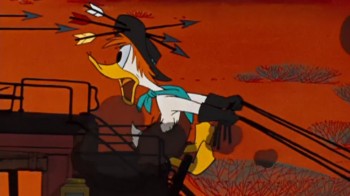 I had seen Donald in Mathmagicland many times prior to ever seeing this newer film. I can’t say I have the same love for Donald and the Wheel. I had a very hard time accepting the two narrators: the Spirits of Progress, Sr., and Progress, Jr. They’re silhouettes done using the Sodium Process invented by Ub Iwerks and used in Hitchcock’s The Birds and Disney’s Mary Poppins. The halo around the characters is all we see of them, and they’re boring, and their song was worse. (I remember spending a lot of time back then trying to figure out how they were done.) As 2719 Hyperion points out Donald and the Wheel did some experimenting with the Xerographic process preparing the way for features like 101 Dalmatians and Sword In The Stone.
I had seen Donald in Mathmagicland many times prior to ever seeing this newer film. I can’t say I have the same love for Donald and the Wheel. I had a very hard time accepting the two narrators: the Spirits of Progress, Sr., and Progress, Jr. They’re silhouettes done using the Sodium Process invented by Ub Iwerks and used in Hitchcock’s The Birds and Disney’s Mary Poppins. The halo around the characters is all we see of them, and they’re boring, and their song was worse. (I remember spending a lot of time back then trying to figure out how they were done.) As 2719 Hyperion points out Donald and the Wheel did some experimenting with the Xerographic process preparing the way for features like 101 Dalmatians and Sword In The Stone.
But I do pine for the time when a feature – not even a Disney feature – would be accompanied by two such animated shorts. Seeing a Pixar short attached to a Pixar long is not the same thing, believe me. 1963 was also a time beyond the Saturday morning kids matinees in theaters when 10 “Color Cartoons” were featured with a Francis the Talking Mule film. No, it was just part of the filmgoing process to be able to see an animated short on a big screen.
- This week I received an email from Louai Abuosba. Along with a number of others, he’s come up with a “meetup.com group aimed at providing a structure for student and professional NYC area. Animators to teach each other skills they don’t have or want to sharpen.” They met this past week in Dumbo and have plans for future meetings. If anyone is interested, you can sign up using Facebook or just go to the site and send Louai a note. (Sorry I didn’t get this out in time for the Sept. 1st meeting, their first, but I got the information too late to get it on the Splog.)
Commentary 27 Aug 2011 07:02 am
Saturday Scribbles
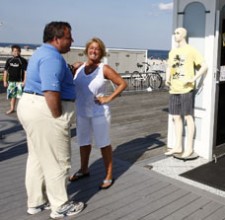 - There’s a panic going on throughout New York and New Jersey. NYC is scheduled to be in the direct line of Hurricane Irene. Meteorologists have, at last check, scheduled the eye of the hurricane to pass over Manhattan. Should be fun.
- There’s a panic going on throughout New York and New Jersey. NYC is scheduled to be in the direct line of Hurricane Irene. Meteorologists have, at last check, scheduled the eye of the hurricane to pass over Manhattan. Should be fun.
On Thursday night – two days before the storm hit – Gov. Chris Christie declared a “state of emergency” in New Jersey. Since it was barely raining on Thursday, I thought that was a bit of cheek, but perhaps the Mad Gov is afraid of what may happen. You’re in good hands in N.J. Oh wait, Cuomo did the same on Friday in NY.
Mayor Bloomberg, on the other hand, took his
 own steps. He demanded evacuation of some hospitals and senior centers that seemed to be in the way of the storm. He also announced that ALL mass transit would be halted during the course of the storm. That means from Saturday noon to Monday morning, who knows when, there’ll be no buses or trains running. I guess we’ll have to walk to make it work when the expected hurricane passes Sunday afternoon.
own steps. He demanded evacuation of some hospitals and senior centers that seemed to be in the way of the storm. He also announced that ALL mass transit would be halted during the course of the storm. That means from Saturday noon to Monday morning, who knows when, there’ll be no buses or trains running. I guess we’ll have to walk to make it work when the expected hurricane passes Sunday afternoon.
Of course, as I recently detailed, I assume there’ll be flood conditions inside my studio and have taken a lot of preparations. The last will be to get the cat to higher ground for the duration. He’ll come back with me to my apartment to face two other cats who live there. Lots of hissing and spitting expected atop the heavy sound of rain on the skylight. I’m not looking forward to the aftermath. Though maybe, like the last hurricane, it’ll be all panic and little reality. That’d be nice.
- This past Monday, it was a beautiful day in New York. Under the shadow of the Empire State Building, that evening, there was a program of early and late Bill Plympton films showing at the Big Screen Plaza.
 This is an outdoor arena with a very big screen overlooking a food court. Lots of tables and seating places around a rectangular fountain makes for a pleasant ambience for watching animation. They’ve finally gotten it together and have their sound problems repaired (something encountered at a couple of earlier screenings this Summer.)
This is an outdoor arena with a very big screen overlooking a food court. Lots of tables and seating places around a rectangular fountain makes for a pleasant ambience for watching animation. They’ve finally gotten it together and have their sound problems repaired (something encountered at a couple of earlier screenings this Summer.)
As the films played overhead, Bill sat at a table in the back where you could buy a copy of some of the cartoons, or his big book. Or, you had the chance just to meet Bill.
The center film of the program was a screening of Bill’s first feature, The Tune. It’s been quite a while since I’d seen this film, so it was a pleasure to rejoin it. The Tune feels like early Plympton, and that’s a wonderful thing. Lots of metamorphosis and surprise distortions and complete nonsense thrown your way, all to the score of songs played throughout, as the lead character searches for a hit tune.
And, as I said, the weather was brilliant.
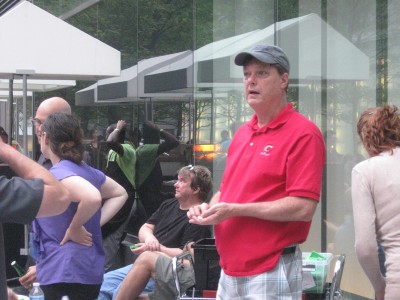
Bill Plympton, as ever, was the gracious host.

Jaime Ekkens is the coordinator for all Big Screen events.

The film played overhead in the beautifully crisp NY evening.
________________________
- On the Ghibli Blog recently, there have been a number of key posts. Principal among them was the news that Madhouse Productions in Japan has stopped work and pulled all production on the completion of The Dreaming Machine, Satoshi Kon‘s last film. When Kon died last year the studio, under the supervision of designer Yoshimi Itazu, was continuing work on the film. It’s obvious that budgetary cuts have stalled this work and have put it into a full stop even though work was half done. It’s questionable if the film will continue work and complete this master’s final production. Satoshi Kon, of course, is the director of “Millennium Actress”, “Tokyo Godfathers” and “Paprika.”
- Back on Aug 12th, the Ghibli Blog posted this CNN video, an interview with Hayao Miyazaki about the formation of Studio Ghibli. He talks about the inherent problem of an animation studio: at first you form the studio to do the work; then it gets so you do work to keep the studio running. The cart pulls the donkey.
________________________
I received the following note and request, this week. I thought it worthwhile to promote it:
- I’m a recent graduate of California State University, Northridge’s Animation program, and I’ve recently released my final short film online. Tanks for Nothin’ is a fun little 50′s, retro cartoon about an imaginative tomboy named Lucy, who uses her creativity to get back at her mean older brother. I spent a year developing and animating “Tanks”.
It’s got a great musical score, and every last frame has been lovingly assembled. The only thing it’s lacking is an awesome sound design. I’ve been approached by a talented Sound Designer from an Academy Award winning animated short, who’d like to collaborate on my film. I’m using Kickstarter.com to raise the funds for the sound studio overhead.
If you’re not familiar with Kickstarter.com, it’s a site that helps art projects raise funds from online backers in exchange for rewards. In the case of my project, backers can earn original signed artwork (I’m just starting out, but I plan to make great animated stories for years to come – this is a chance to get my “Rookie card”), a DVD of the finished film, movie posters, and even their name in the credits. I’ve heard most projects are funded by under 5 dollar pledges. Kickstarter is an all-or-nothing platform, so if the project doesn’t reach its goal no money changes hands.
If you think this is a worthwhile project please help out by telling your friends about it via Facebook, Twitter, Tumbler, Linkedin, etc. I really need help getting the word out there (I only have until Monday Aug 29, 3:02am ET. left to raise the funds).
Tanks for Nothin’ site.
I don’t intend to turn my site into an open venue for everyone, but thought this project of interest, and I hope it does well.
- I also wanted to post a reminder that Grayson Ponti has one of the best blogs out there (for animation freaks, that is.) The 50 Most Influential Disney Animators offers good bios and passable critiques of many different Disney animators, past and present.
Of course, the two inherent problems with the site are that many great and brilliant animators didn’t work for Disney. They’re all left out.
So, too, are all the wonderful story artists/writers and production designers that have seriousl affected the films (both Disney and non).
Commentary &repeated posts 20 Aug 2011 07:11 am
Iwerks Recap
This is a piece I originally wrote in October 2006 for this blog. I wanted to reprise it given the amount of attention I’d given Iwerks lately re Tim Susanin‘s book, Walt Before Mickey, and the Iwerks multiplane camera.
- From my earliest days, as soon as I’d learned who he was, I was a fan of Ub Iwerks.
Ub Iwerks.
I began to wonder if it was just the publicity and myth of Iwerks which had followed with him all these years. We read about all those 1930′s East coast animators moving to the West, not to work for Disney but to seek out Iwerks – it was well known that he was the “true artist” behind those Disney shorts.
With Bob Thomas’ 1958 book, The Art of Animation, I read, for the first time, about Iwerks and his importance. Only recently did I begin to wonder how responsible Iwerks actually was to Disney’s success. Was this just that myth being carried over the years? Or was he brilliant?
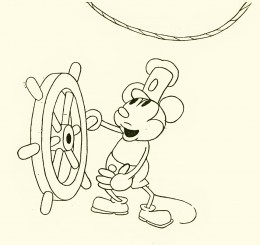 A quick look at the animation done at the time and we see some basics not yet developed.
A quick look at the animation done at the time and we see some basics not yet developed.
There weren’t many stories written before Disney, so animators divided up their pictures. For example: They’d decide to do a film where Mutt & Jeff would go to Hawaii. One animator would start on the beach and end with them on surfboards. The animator would make it up as he went along until he turned out the required footage – maybe 2 minutes of work. The next animator would pick up Mutt & Jeff on surfboards and take them to being washed up on the beach, etc.
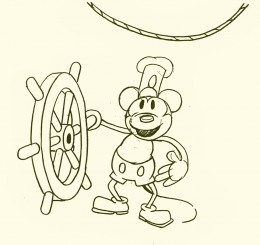 Obviously, the lead animator doled out rudimentary plot points, but a lot was left to the individual animator. Look at the book, Walt In Wonderland by Russell Merritt & J.B. Kaufman to see how Disney started developing stories during this period.
Obviously, the lead animator doled out rudimentary plot points, but a lot was left to the individual animator. Look at the book, Walt In Wonderland by Russell Merritt & J.B. Kaufman to see how Disney started developing stories during this period.
The same was true for animation techniques and methods. Animation burst out of its seams with the creation of Mickey Mouse. Disney had initiated a lot of ground work, but the medium really started growing with the enormous success of Steamboat Willie. Iwerks led the way, not only by the amount of work he did but the quality.
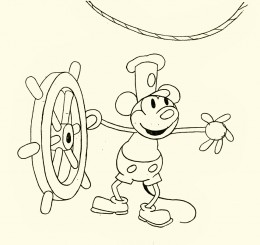 Take a look at these five Iwerks drawings from that short.
Take a look at these five Iwerks drawings from that short.
One of the first lessons an inbetweener learns is that a face turn shouldn’t have a direct middle in it. The middle drawing (#3 here) shouldn’t be straight on; it should favor, slightly, one side or the other.
Despite the simple drawings of Mickey, Ub Iwerks seemed to understand this instinctively. He didn’t really get lessons from anyone. As a matter of fact, he was creating the rules. This comes close to being straight on, but the mouth gives it away. The face is facing screen left.
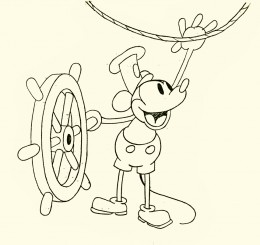 Another simple inbetween lesson is to offset the inbetween (usually an animator or good assistant will set this up for the inbetweener.)
Another simple inbetween lesson is to offset the inbetween (usually an animator or good assistant will set this up for the inbetweener.)
Here Mickey is standing upright on #1 and he’s upright on #5. Drawing #3 has him with knees bent, beating in tempo to the sound. Even though this is from the first sound cartoon, done in 1928, the offset rule is in effect.
I think it’s pretty clear that some sophistication has entered the animation that Iwerks was drawing. This same sophistication isn’t in other animator’s work.
(Click any image to enlarge.)
Add to this the fact that Iwerks was probably the fastest producing animator, and you probably have good reason for knowing he was the genius behind Disney.
This, of course, didn’t remain that way. After Iwerks left, leaving behind enough animators trained by him, their work developed exponentially. Better artists were entering the studio and bringing their talents to the work, and they started making a serious attempt to improve the work.
Iwerks stopped animating and stopped trying to improve the character animation. Instead, he tried to improve the camera – actually developing the mulitplane camera in his own studio. Animation, under Iwerks, didn’t develop.
The book by Leslie Iwerks & John Kenworthy, The Hand Behind The Mouse, gives some solid information that wasn’t previously published and puts a lot of material into perspective.
Now we have Walt Before Mickey: Disney’s Early Years 1919-1928. by Tim Susanin. This is a thoroughly researched and reliably accurate book which gives a good account of Iwerks’ contribution up to and including Plane Crazy.
Commentary 15 Aug 2011 06:54 am
Iwerks Multiplane
- Continuing back in time looking at the multiplane camera, you have to finally reach Ub Iwerks at his studio. It’s probable that Iwerks was the first real inventor of the idea. His studio put it into use far earlier than either Disney and Fleischer. It was most probably more limited than the other two, but the germ was there. On film, the new tool appeared in 1934. At different times, both Grim Natwick and Shamus Culhane talk about Ub working furiously in the basement on a multiplane camera built out of auto parts. The camera was a horizontal multiplane camera with the cels standing up, shot against levels of depth. Looking at the existing films it’s hard to find many uses of it. I came up with two Comicolor Films – two fairy tales, that Iwerks produced.
The first is The Headless Horseman (1934), and the camera is used in a very limited way, here. In fact, the scene could have been done with multiple levels panning at different speeds. This is used only in panning scenes. I’ve taken one of these repeated scenes and illustrate with that.
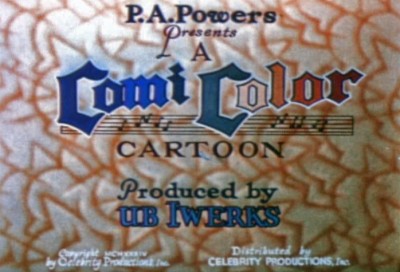 1
1
It took them a while to settle on one opening title for this series of tales.
 4
4
The three principal characters are introduced via
a multiple exposure three-way split screen.
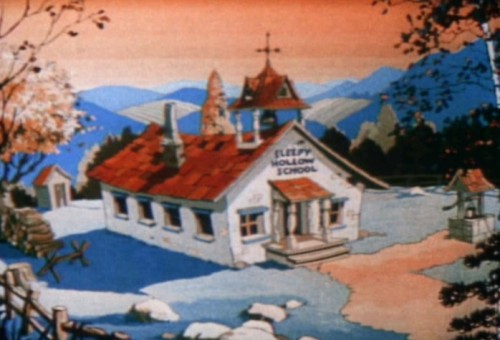 5
5
Which leads us into a flat BG of the schoolhouse.
Considering there’s a truck in, one would have thought
that the multiplane could have been used for good effect.
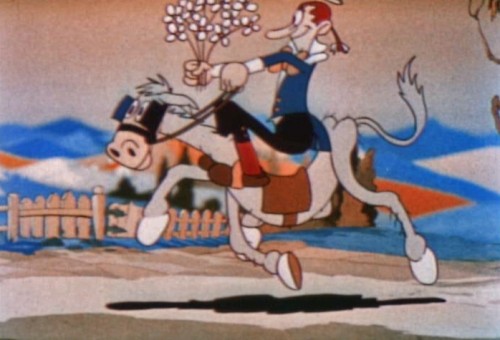 6
6
Most of its use was for these panning scenes with multiple levels
that aren’t even taking advantage of the soft focus possibilities.
 10
10
This scene has nothing to do with the multiplane camera,
I just like it.
The Valiant Tailor (1934) is much more energetic. Again, the camera is used only for panning, no camera moves in or out. The BGs are broken into multiple levels and the focus is very soft in the distant background (never in the foreground.) The levels move at different speeds and oftentimes look like they’re bicycle pans in that some parts of the levels repeat in the moves. (I can’t think of any other studio that did that.) In different scenes, it also looks as though some of the back levels have been moved closer, to a more foreground position. The shadows animate over the surface of the ground they touch.
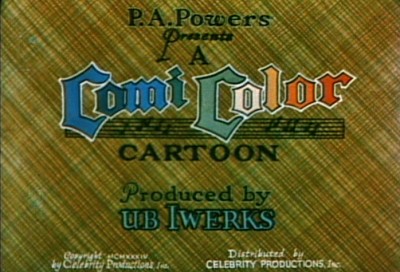 1
1
This is the only film that uses this criss-crossed BG.
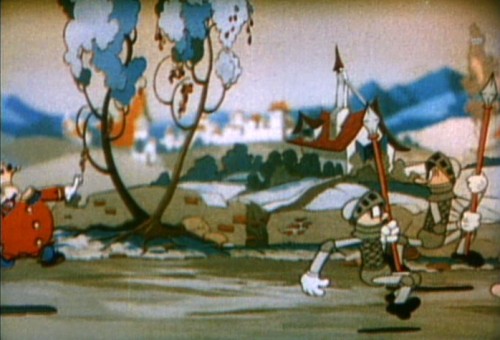 7
7
The sharp focus of the foreground level against the soft BG
is the feature of this scene. It plays so well in motion.
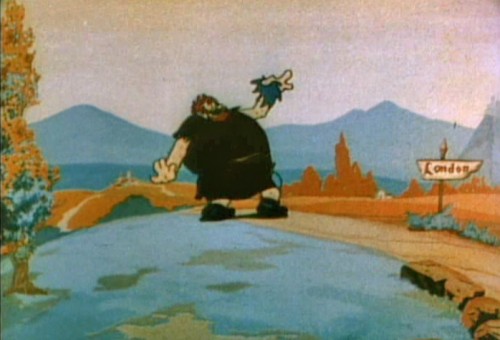 15
15
We cut to this flat scene . . .
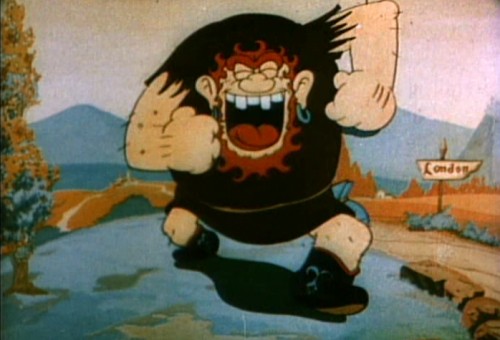 16
16
. . . but it’s very dynamic.
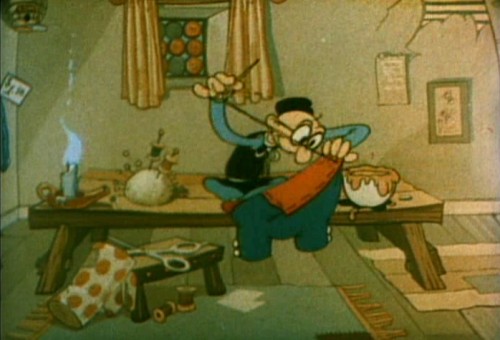 17
17
The tailor is flat in this first scene, but
the scene seems to be purposefully dim.
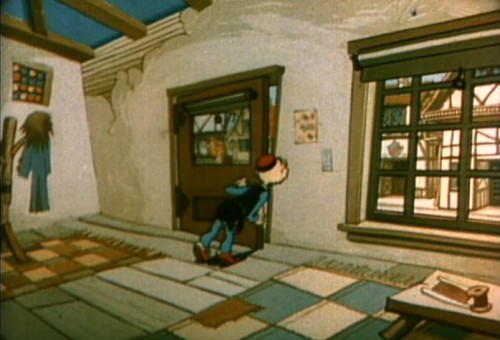 18
18
When he goes to the door, the bright, sharp focus outdoors
tells us this was shot on the multiplane.
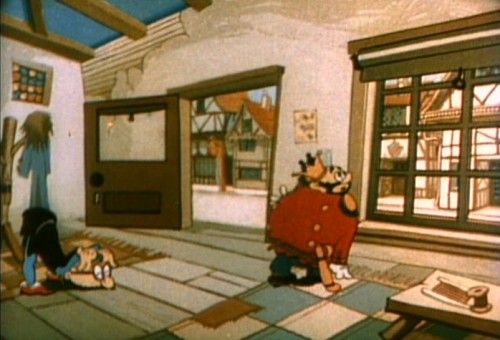 19
19
This exposure really shows how it should’ve been exposed throughout.
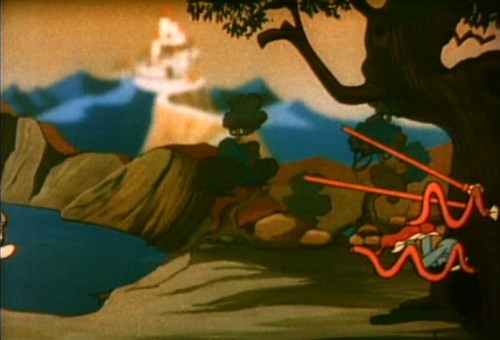 21
21
Again, it’s the sharp focus against the soft that makes this effective.
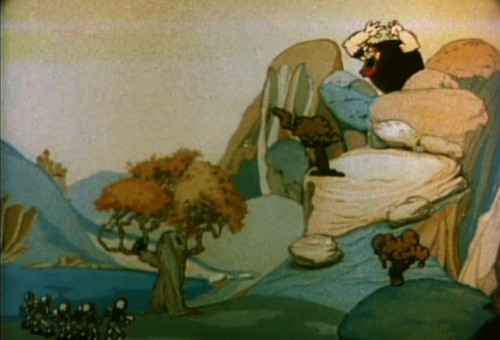 22
22
A flat scene cut into two using multiplane.
Animation &Commentary &Independent Animation 14 Aug 2011 03:08 am
Robert Breer (1926-2011)
- This note came from George Griiffin today:
- Some of you may already know Bob died yesterday. The beautiful film by his youngest daughter Sally, posted on Vimeo, made it clear but I don’t know if there has been an official announcement yet.
Unfortunately, I did not receive a link to the video
but Janet Benn located it. Thanks, Janet – M.S.
He had an enormous influence on 2 generations of animation artists, constantly pushing and pulling his practice with wit and ingenuity. It was a privilege to have known him, and to have learned so much from him. A huge force in our field has left.
There is this excellent bio on AWN.
See some of his films Here.
The only obituary I’ve found thus far is an Italian one, in Italian. Here. It says that he died peacefully on August 12th.
Commentary 13 Aug 2011 06:48 am
Rambling Bits
- This past week things kept moving. It started with the news that Standard and (very) Poors had lowered the credit rating of the US, and the stock market rolled up/down/up/down ending UP. It’s frightened quite a few people waiting for the “double dip Recession”. Did John Boehner & Eric Cantor think they would have any other result than this with the past month’s game playing in Congress? Or maybe that was what they wanted, so they could blame the President for it. A made-up crisis has put the US on the brink of a real crisis, and, by nature, the Global Economy as well.
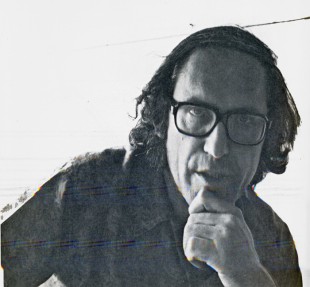 Then came the more personal news that Corny Cole had died. That was something of a shocker and a very sad one at that. Corny seemed to inspire many in animation today. As one of the heads of CalArts animation program, he’s affected many of the students lives as he inspired many of them on or into the business.
Then came the more personal news that Corny Cole had died. That was something of a shocker and a very sad one at that. Corny seemed to inspire many in animation today. As one of the heads of CalArts animation program, he’s affected many of the students lives as he inspired many of them on or into the business.
There are quite a few blog notes out there. My three favorites are
- – the odd interview posted on Mike Barrier‘s website, MichaelBarrier.com. Corny talks about his days working in Chuck Jones’ unit at Warner Bros., his ________Corny in 1976 on RAGGEDY ANN
days at UPA on Gay Purr-ee and his work
for Richard Williams on The Cobbler & the Thief. There’s a slight paranoia there, and Corny seems to think that others are out to beat him. I’m not sure, from what he says, that that was really an accurate reading. But what do I know?
- On The Animation Guild Blog Dave Brain offers his memories of Corny.
- on Cartoon Brew, Amid Amidi collects a lot of blog posts and points to many of them.
I remember Luis Bunuel‘s introduction to his great autobiography. He was aware that his death would come within another year or two, and he said that he didn’t mind dying if only he could come back once a year to read some of the newspapers because he was addicted to the news and would want to know what happened in the soap opera of life. This hit very close to home. I love the politics of the world (not so much lately now that it’s all good vs evil/black vs white) and would want to continue knowing what’s going on. When I see the culmination of one political event mesh with a friend’s passing, I always wonder about this Bunuel thought. I know, I’m nuts.
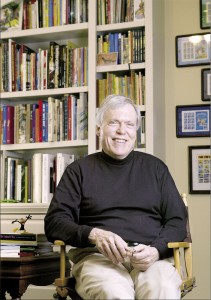 - Speaking of Michael Barrier and his site. Every time he publishes a new interview a lot of attention is garnered. What seems to be forgotten is that Mike has recorded MANY interviews and he has many in the archive of his site. Right up there at the top, on his banner, it says interviews.
- Speaking of Michael Barrier and his site. Every time he publishes a new interview a lot of attention is garnered. What seems to be forgotten is that Mike has recorded MANY interviews and he has many in the archive of his site. Right up there at the top, on his banner, it says interviews.
There you can find quite a few that were originally published in Funnyworld Magazine: Hugh Harman, James Bodrero, Frank Tashlin, John McGrew, Art Babbitt, Dave Hand and many other key personnel from the Golden Age of animation.
They’re all there – for free. You just have to read them.
It’s an amazing resource; take advantage. (I must have read the Dave Hand and John McGrew interviews at least four times, each. I’ve memorized the Hubley interview.)
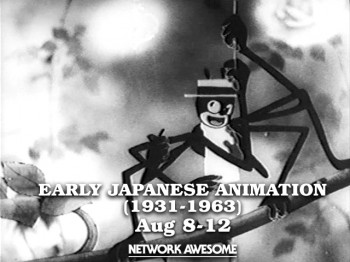 - Another very interesting site came to my attention early this week. Network Awesome features a lot of archival videos. Jason Forrest founded the site in January 2011. With it he says he’d like to: “spotlight the best from the past to create something new for the future. In a sense it’s TV about TV but our wider intent is to show something about culture as a whole. This can manifest itself in a kids cartoon from 1973, an interview from 1948 or a movie from 1993.”
- Another very interesting site came to my attention early this week. Network Awesome features a lot of archival videos. Jason Forrest founded the site in January 2011. With it he says he’d like to: “spotlight the best from the past to create something new for the future. In a sense it’s TV about TV but our wider intent is to show something about culture as a whole. This can manifest itself in a kids cartoon from 1973, an interview from 1948 or a movie from 1993.”
You can find anything from an early Astro Boy adventure to The Grave of the Fireflies. This past week they’ve had something of a festival for very early Japanese animation, hosted by Cory Gross. All of these films are extraordinary and certainly worth viewing. Many of them seem to use an early version of the multiplane camera in shooting. The animation style starts looking like a Fleischer clone, and eventually goes more toward Disney.
Here’s what they programmed this past week:
- 1. Fox and Racoon-Dog Playing Pranks on Each Other (1933)
2. Kenzo Masaoka’s Spider and Tulip (1943)
3. Momotaro’s Divine Sea Warriors (1945)
4. Koneko No Rakugaki (1957)
They also have an on-line magazine which gives detailed information about each film on the site. Here’s a sample of the page for Spider and Tulip. It tells who Kenzo Masaoka was and what his role in the history of Japanese animation was. The film was animated during the height of WWII, so the implications are obvious. Yet compare it to what Disney was doing at the time; it’s an amazing piece.
- I also reviewed Timothy Susanin’s book, Mickey Before Mickey: Disney’s Early Years 1919-1928. I hardly believed that my review would lead to a conversation via email with Mr. Susanin. I have to say that it was a treat. The book made a strong impression on me.
Lately, I’d been reading a lot of interviews with people around the Disney studio in the 20′s, 30′s and early 40′s. Didier Ghez’ spectacular series of books: Walt’s People Vols 1-11. I only have three, but it gives me plenty to look forward to. Working with Walt and Working With Disney, both by Don Peri. These two are juicy books and have some excellent interviews within. Consequently, reading Mr. Susanin’s book came at exactly the right time for me. While reading that I pulled the two Barrier books off the shelf: The Animated Man and Hollywood Cartoons as well as the Kaufman and Merritt book, Walt in Wonderland. I’d already read each of these three several times, but it was fun rereading them while seeing how much Mr. Susanin added to the picture (and it often was a lot.) For some reason, this offends a number of reviewers, such as Charles Solomon in the LA Times. I don’t quite know why. Perhaps, he just wants to get the Cliff Notes in history books. I want all the meat and bones and gristle. Perhaps, Mr. Susanin wrote his book specifically for me. It certainly got me charged.
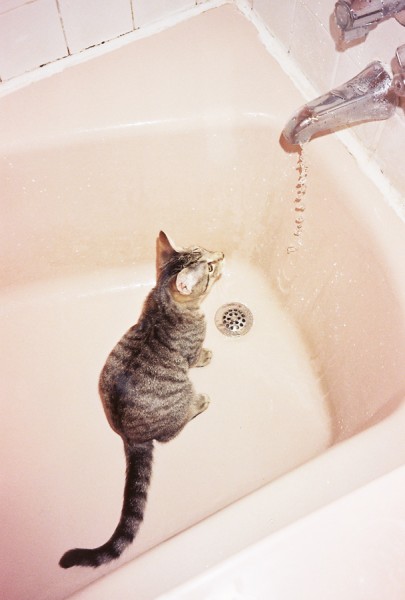
Alex, one of our cats, has always had a fascination with water.
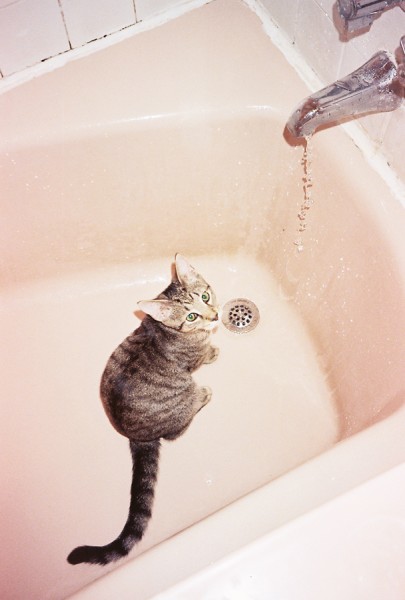
He’s now fully grown and sits in the bathtub under the dripping water.
He comes out with a soaking wet head and
likes to hit you in the face with it.
Animation Artifacts &Books &Commentary &Disney 11 Aug 2011 06:52 am
Response
- On Tuesday, I’d posted a review of Timothy Susanin‘s excellent book, Walt Before Mickey: Disney’s Early Years 1919-1928. I loved the book and, in fact, worried that I was being too critical. I did tend to go on quite a bit about the details on details within the book.
To my surprise I’d received an email response from Mr. Susanin, and I asked him if he would mind my posting his letter. He immediately gave me permission and here’s his response to my review:
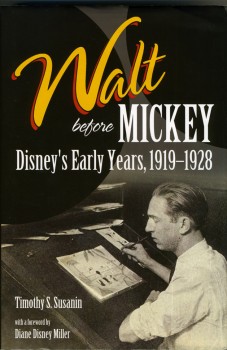 Dear Mr. Sporn,
Dear Mr. Sporn,
Many thanks for reading my book; for writing a review; and for your kind words.
I can’t tell you how much fun I had learning the story of Walt’s first decade. It was a most enjoyable and unexpected hobby, and I am sorry it’s over!
I am biased about Walt, of course, so I found the subject matter thrilling and a page turner, like you.
Your review is dead on in a number of respects. I am a Disney fan, not an animation expert, thus I was not equipped to search for the art, as were J.B. and Russell. Being a lawyer who has done many investigations, and written many detailed factual reports based on investigations, I was simply all about finding out what happened during Walt’s “missing decade.”
There was a reference in the Laugh-O-gram bankruptcy file to a studio “minute book,” and I would have been thrilled had a daily diary of any or all of that decade still existed! For me, following Walt day by day was the way to learn the real Walt and to see how he really got started.
So for me, a novice author and biographer — and maybe this notion would not be acceptable to other, experienced authors and biographers — there was real worth in learning all of the detail you mention in your review. Because no daily account existed, trying to find out at least what he was doing on a monthly basis helped bring this period alive for me.
The overload of detail — again, for me — allowed the physical spaces he occupied, the friends and colleagues, the look and feel of the period, the films produced to all come together and create a real portrait of that missing decade.
I agree that the question is: is this a viable biography for others outside this “niche market?” I didn’t set out to write a book, and once a book resulted, it was the book I would have wanted, because of the level of detail I wanted to know in order to really learn that period of Walt’s life. So, it worked for me!
And, as you point out, there were limitations. I had no budget. I had no publisher until the book was finished. I was not sure until near the end of the process that the Disney Company would provide photos.
So….this was very much a project where I was limited to take what others had done
and try to build on it, add facts to it, string things together, on my own and in my
spare time —- evenings and weekend.
I pulled all this together to learn about Walt in the 1920s. The info turned into a timeline that turned into a more detailed chronology that turned into a book. Along the way, I tried to find answers to whatever questions I had so that the blanks could be filled in.
I think what resulted is a work that I would have loved to come across in a book store or in a library, along with the realization that others would feel the same way, but maybe not a lot of others!
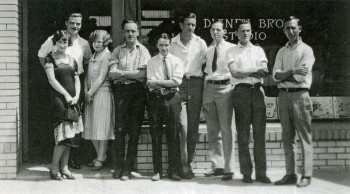 In the end, I got a real sense of who Walt was; what the first ten years of his career were like; how they set the stage for the rest of his career; and how a lot of his original collaborators fit into the big picture. It really sets the table nicely for me to now go on and read and learn about Walt in the 30s, 40s, etc.
In the end, I got a real sense of who Walt was; what the first ten years of his career were like; how they set the stage for the rest of his career; and how a lot of his original collaborators fit into the big picture. It really sets the table nicely for me to now go on and read and learn about Walt in the 30s, 40s, etc.
Unlike you, I did not want the book to go on. After six years and many rewrites and endless proofreading, I wanted it out the door and almost got sick of it! Maybe you can predict what happened after that: I now find myself wondering with increasing frequency about the spring of 1928, and what happened —- in a detailed way, on a daily or monthly basis! —- as Mickey appeared on the scene.
I thought that I would have nothing further to contribute to the Disney canon because, from Mickey’s appearance in 1928 til today, enormous amounts have been written about Walt’s story. Unlike the “missing decade” of the 1920s, the record is complete as far as the other decades of Walt career are concerned.
And yet….I find myself getting the urge to dig into the spring of 1928 and see where that takes me.
I don’t really know if I have another book in me, but my mind is starting to wander in that direction. I’ll keep you posted!
Many thanks again for your interest and your review.
Boy, do I hope he comes up with something about those several months between the start of Plane Crazy and the premiere of Steamboat Willie. Can you imagine the pressure on Walt and Roy? They’d just been robbed of their staff and had lost a semi-lucrative job doing Oswald cartoons. They create a mouse character, and no one wants the first short. So they do a second film starring Mickey, and still they can’t sell it. They do a third one trying to capitalize on the incoming sound transition. They show the film at one theater – for free – just to get it in front of an audience. Success! That short period is a tale in its own, and it’s never really been covered by writers.
In the photo, above: LtoR – Irene Hamilton (Inker), Rudy Ising, Dorothy Manson (Inker), Ubbe Iwerks, Rollin Hamilton, Thurston Harper, Walker Harman (Inker), Hugh Harman, Roy Disney. Walt took the photo.
On to something else that’s related. Mark Sonntag on his extraordinary blog, Tagtoonz, has posted some rarely seen photos of the first days of Disney’s filming in Kansas City. After posting the one photo of Walt directing and Red Lyon filming the Cowles children in 1922, he was contacted by a member of the Cowles family, and they offered additional photos. Take a look.
Commentary 06 Aug 2011 05:02 am
Bits of Pieces

Tissa David study for The Marzipan Pig
- During the summer months, it seems that HBO is airing one of the Sporn films every day and screening each film twice. Once at 7:30am and again at 10:00am (EST). You can locate the complete schedule on our main website. Just click the “August” button.
- In case you haven’t seen this yet, here’s a photo of the original desk Walt Disney built in his Uncle Robert’s garage when he began work on his Alice in Cartoonland series. This was just after his move to California. Having finished the first of the Alice films, he was able to sell Margaret Winkler on this new series. Fortuitous timing. She was distributing the very successful Felix series, and Pat Sullivan was pulling out from her distribution after his contract expired. She needed a new series to take its place, and hoped that the Alice series would do just that.
The camera, itself, was bought used for $200. Walt built the stand, himself, and used the camera for both the live action and the animation. Presumably this was the stand on which Steamboat Willie was shot. The photo was taken in the Natural History Museum of Los Angeles where Disney donated the stand.
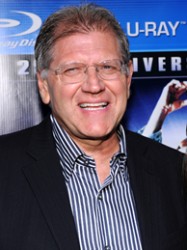 - From the “Hard to keep a good man down” department, Robert Zemeckis is signing with Universal Features to bring his Imagemovers company to their lot. This is the group that was just pushed out of Disney after the losing track record of Mars Needs Moms and Beowulf. The Universal deal would be an overall production pact. Terms and length are still being finalized, but the arrangement would call on Zemeckis to develop and produce both live-action and motion capture projects.
- From the “Hard to keep a good man down” department, Robert Zemeckis is signing with Universal Features to bring his Imagemovers company to their lot. This is the group that was just pushed out of Disney after the losing track record of Mars Needs Moms and Beowulf. The Universal deal would be an overall production pact. Terms and length are still being finalized, but the arrangement would call on Zemeckis to develop and produce both live-action and motion capture projects.
It’s not yet known whether the film he just contracted to do for SONY, How to Survive a Garden Gnome Attack, would be done on this deal. The good news is that we can still see a motion capture version of the Beatles’ Yellow Submarine.
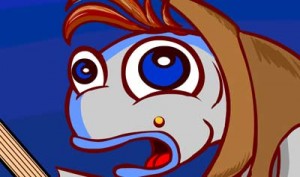 – Lee Corey writes that he recently completed 30 sec PSA with the music group he designed, “Walleye and the Fish Band”. The PSA is playing in 360 theaters in the Great Lakes area. The spot confronts the problem of about VHS disease, (viral hemorrhagic septicemia), a disease which has decimated 17 species of fish in the Great Lakes, and while it is not contagious to humans, it is severely affecting the aquaculture of the region.
– Lee Corey writes that he recently completed 30 sec PSA with the music group he designed, “Walleye and the Fish Band”. The PSA is playing in 360 theaters in the Great Lakes area. The spot confronts the problem of about VHS disease, (viral hemorrhagic septicemia), a disease which has decimated 17 species of fish in the Great Lakes, and while it is not contagious to humans, it is severely affecting the aquaculture of the region.
On completion of the PSA, Corey was hired to do a two minute music video featuring the band singing its “hit” song “Help Save Our Waters” with lyrics suggesting tips anglers and boaters can take to help stop VHS disease.
- Bill Plympton and Pat Smith have put together a program of new 2D films to be screened in Williamsburg, Brooklyn next Sunday night. They call it the Scribble Junkies Festival of Drawn Animation. Hallelujah! Someone is still giving drawn animation some respect. We need more of this. Tony White’s 2D or Not 2D Festival is another incarnation of this on the West Coast, and we hope lots more start showing up.
Drinks start at 7pm, screening at 8:30. It includes recent work by animators Ryan Woodward, Bill Plympton, Patrick Smith, David Chai, Colleen Cox, Rebecca Sugar and more! Hope to see you! For more info go to the blog.
Sunday, August 14 at 7:00pm
Location: Nite Hawk Cinema, 136 Metropolitan Ave.
- The Rauch Brothers, again, this year will have short films accompanying the POV show on PBS. No More Questions and Miss Divine are scheduled to air on Aug 23rd.
Commentary &SpornFilms 30 Jul 2011 06:54 am
Grab bag
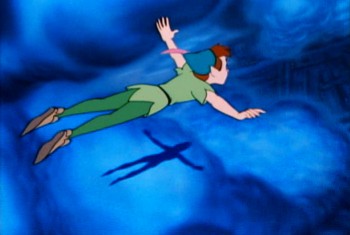 - A month ago, I did a post on the use of the multiplane camera in Peter Pan. Thanks to some comments and questions by Milt Gray, I was made to question whether the flying sequence from the feature was done with multiplane or many-leveled out-of-focus-painted clouds. One quote in Bob Thomas’ original book, The Art of Animation, settled the question for me. In listing some of the great sequences done using the multiplane, Thomas lists this flying sequence: “Another memorable sequence: the flight over London in ‘Peter Pan,’ with the runaways (or flyaways) sailing through the clouds. The scene was painted by Claude Coats.”
- A month ago, I did a post on the use of the multiplane camera in Peter Pan. Thanks to some comments and questions by Milt Gray, I was made to question whether the flying sequence from the feature was done with multiplane or many-leveled out-of-focus-painted clouds. One quote in Bob Thomas’ original book, The Art of Animation, settled the question for me. In listing some of the great sequences done using the multiplane, Thomas lists this flying sequence: “Another memorable sequence: the flight over London in ‘Peter Pan,’ with the runaways (or flyaways) sailing through the clouds. The scene was painted by Claude Coats.”
But now, Hans Bacher, on his brilliant site One1more2time3′s asks the question again. This time Hans, in his stunning way, has reconstructed the enormous Bg of this scene, then reconstructs the layout of the scene (with its many complicated rotations and pans), and finally details why he believes it did not use the multiplane camera. This is an amazing post and is throughly deserving of a long look at what Hans has constructed. I’m in awe.

A layout posted on Hans Bacher’s blog
But that Thomas quote still keeps me questioning it. After all Thomas would have been writing the book in 1957 or 58, and surely the people involved in this scnre were among those Thomas spoke to. In fact, Claude Coats is given some strong attention in the book. Would he have gotten it wrong to call the scene a multiplane camera scene? I’m not convinced.
 - Leo Sullivan and Floyd Norman have teamed together to work on an animated short about the Tuskagee Airmen. The short, titled The Tuskegee Redtails, has just been posted to Kickstarter; the film makers are seeking to raise $55,000 for the production.
- Leo Sullivan and Floyd Norman have teamed together to work on an animated short about the Tuskagee Airmen. The short, titled The Tuskegee Redtails, has just been posted to Kickstarter; the film makers are seeking to raise $55,000 for the production.
Some of the description given on Kickstarter reads:
- The Tuskegee airmen were so called because most of the African American pilots were trained at Tuskegee University in Alabama during the 1940s. Through their bravery and actions, the Tuskegee airmen joined the ranks of other patriotic Americans who defended the United States of America against the Axis military powers during World War 2.
The animated short will take a snapshot in time of the Tuskegee airmen obstacles and achievements.
The film will be “an animated short in 2D combined with CGI animation approximately 20 minutes.”
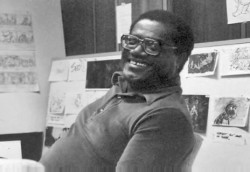 Leo Sullivan‘s bio reads: “Leo Sullivan is the President/CEO of Leo Sullivan Multimedia, Inc. a California S-Corporation which produces educational and entertaining media for children ages 5 to 17 years. Prior to incorporating his company, Leo worked in the animation industry as an animator, layout and storyboard artist, director, and producer for various companies which included Hanna-Barbera, Warner Brothers, Spunbuggy Works, Campbell/Silver/Cosby and others. ”
Leo Sullivan‘s bio reads: “Leo Sullivan is the President/CEO of Leo Sullivan Multimedia, Inc. a California S-Corporation which produces educational and entertaining media for children ages 5 to 17 years. Prior to incorporating his company, Leo worked in the animation industry as an animator, layout and storyboard artist, director, and producer for various companies which included Hanna-Barbera, Warner Brothers, Spunbuggy Works, Campbell/Silver/Cosby and others. ”
 Floyd Norman‘s bio reads: “Floyd has contributed his talent to motion pictures, television shows and comic books for over fifty years. He has the distinction of having worked with the Old Maestro himself when the boss recruited him for the story team on what would become Walt Disneyʼs final motion picture.
Floyd Norman‘s bio reads: “Floyd has contributed his talent to motion pictures, television shows and comic books for over fifty years. He has the distinction of having worked with the Old Maestro himself when the boss recruited him for the story team on what would become Walt Disneyʼs final motion picture.
A veteran story development artist, Norman has worked as an animator and story artist on at least a dozen films for both Walt Disney Studios and Pixar Animation Studios.”
I’d recommend that everyone take a look at their proposal and help out if you can. You can give as little as $5, if you’re able and would like to.
It’s interesting that just today George Lucas’ film, Red Tails, announced its opening. On January 20, 2012 the film will open, according to this NYTimes article. I hope the announcement brings added attention to Mr. Sullivan and Mr. Norman’s film.
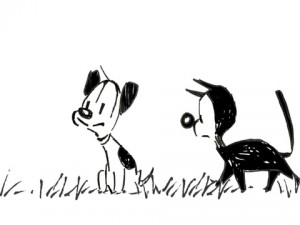 - This week some attention was paid by the animation community when they learned that the comic srip, Mutts, has been singled out to become a future feature with cartoonist/author Patrick McDonnell writing the script with his brother, Robert McDonell. This was the story from The Hollywood Reporter.
- This week some attention was paid by the animation community when they learned that the comic srip, Mutts, has been singled out to become a future feature with cartoonist/author Patrick McDonnell writing the script with his brother, Robert McDonell. This was the story from The Hollywood Reporter.
We had the good fortune a couple of years ago of doing a one minute animated piece for King Features Syndicate. We followed the look of 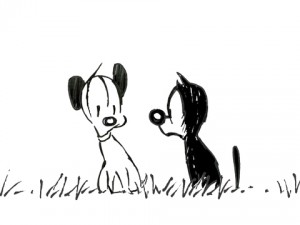 the strip very closely and had a lot of fun doing it. Patrick McDonell was quite involved in the production asking for a number of good changes. If ever there were a strip made to be a 2D animated film, Mutts is it. he film will be made by 20th Century Fox. Does that mean it’ll look more like the Blue Sky films’ Horton Hears a Who, or will it be like Marmaduke and Garfield? (Meaning a live action film with animated characters.)
the strip very closely and had a lot of fun doing it. Patrick McDonell was quite involved in the production asking for a number of good changes. If ever there were a strip made to be a 2D animated film, Mutts is it. he film will be made by 20th Century Fox. Does that mean it’ll look more like the Blue Sky films’ Horton Hears a Who, or will it be like Marmaduke and Garfield? (Meaning a live action film with animated characters.)
Hopefully, Blue Sky will do the animation if it’s cgi. At least they bring a little dignity to their work. Though we all know it should be a 2D film, but the Republicans are dominating the conversation in D.C. and cgi is dominating the conversation in animation.
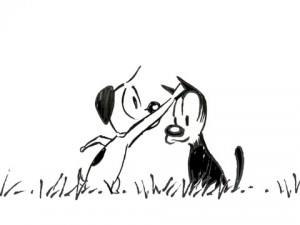
All stills, here, are frame grabs from our spot.
Commentary 23 Jul 2011 07:37 am
Saturday’s Mixed Grabbag
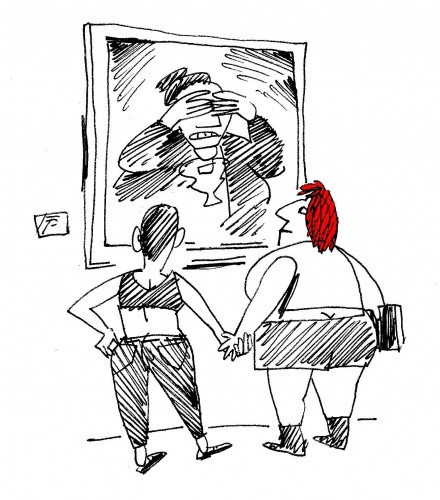
- Recently, NY passed the legal rights for gay and lesbian couples to marry. This has, of course, created a lot of difficulties as many couples rush to try to marry. The first day this is possible will be tomorrow, Sunday, and there’s a rush. They’ve begun something of a lottery to determine which couples can go first.
Here’s a story that developed out of San Franciso as reported by Now What Media:
- At the Contemporary Jewish Museum in San Francisco, at an exhibit entitled Seeing Gertrude Stein, two lesbians were asked to stop holding hands. When they protested they were asked to leave the museum. Let’s see – Gertrude Stein show. In San Francisco. Yes, we read that correctly. The Museum has apologized. The security guard works for an independent company, is not an employee of the museum and obviously knows nothing about the show or San Francisco.
The resourceful Tom Hachtman did the cartoon above (and the earlier one on Now What) which he sent me. Gertrude is always there for the comedy of the event.
It’s amazing how big Comic Con has grown. The NYTimes has many daily reports from the event in their on-line spaces. Honestly, the thing sounds dreadful to me, but I suppose I should get myself out there one of these years just to see what I’m not missing.
.
Yoni Goodman
Yoni Goodman continues to do daily animated exercises on his blog at Dailymotion. They’re no longer quite daily, but they are frequent enough and excellent and worth your checking out.
.
You too can animate Sponge Bob (and pay for it.)
.
 - And now we have news of a new animation creation program. Take a look at this bit of info sent to me this week:
- And now we have news of a new animation creation program. Take a look at this bit of info sent to me this week:
- Smith Micro has announced it has joined with Nickelodeon and NetToons to bring the first-ever SpongeBob SquarePants Tooncast Studio. Now fans of every age and skill level can become part of their favorite show by creating their own pro-quality SpongeBob animations. The SpongeBob SquarePants Tooncast Studio is going to be unveiled at Comic-Con this week.
Using the SpongeBob SquarePants Tooncast Studio, fans can animate SpongeBob and his friends in hundreds of different ways by making them walk, run, jump, dance, and much more—all to the tune of a custom music soundtrack.
They offered to send a demo copy of the program, but I think my life is too short for such things.
.
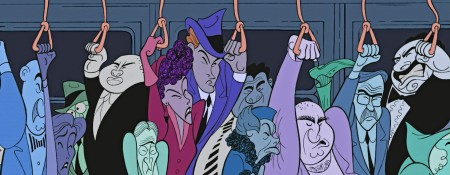
William Benzon, on his blog New Savannah, has an essay about Fantasia 2000. It doesn’t bode well for the newer film to be compared to the origianal Fantasia. A short quick read.
.
Ace and Son
- Not sure what to make of it, as yet, but Richard O’Connor has moved on from Asterisk Animation to Ace and Son. I don’t know if this is a new company or just the name for the new blog, but it seems meaningful and I’ll let you in on any news I find out.
.
Beavis and what?
Are we ready for more Beavis and Butthead? MTV has run short of ideas so they’re going back to oldies but goodies, except they don’t have music videos they can play off of. So there’s Jersey Shore awaitin’. This October.
